Many factors influence turfgrass growth rate. Some are beyond the manager’s control while others are frequently manipulated through normal management. Environmental factors including the recent weather and soil conditions, turfgrass genetics, traffic levels and even the soil microbiome all have a big impact on growth rate, but are difficulty or impossible to control. Other management factors including nitrogen fertilization, irrigation management, mowing practices and PGR applications also have a major influence on growth rate, turf performance, and playability and are easier to manipulate. As more turf professionals strive to hit growth rate goals, it’s important that one factor isn’t the idiomatic “tail wagging the dog.”
Holding other aspect equal – ideal weather, sufficient soil moisture, normal traffic and mowing – nitrogen fertilizer can thought of as the accelerator pedal and PGRs can be thought of as the brake pedal driving clipping yield. If growth is slow, then N fertilizer can usually fix the problem if all other factors are acceptable. When growth is excessive, high application rates or even combinations of PGRs can help bring growth rate back into balance. But what happens when a manager applies too much PGR or nitrogen? Can the counterpoint save the day or only serve as a short-term solution?
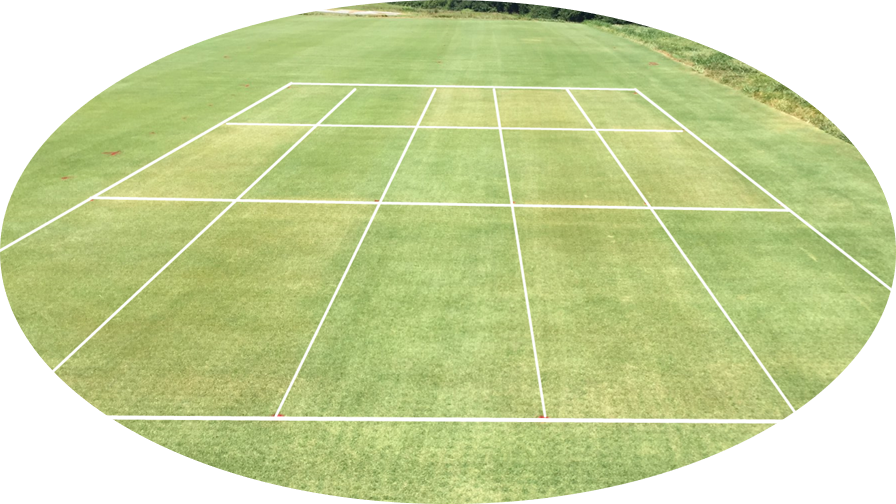
What is the right Amount of PGR Suppression?
The most popular questions following my PGR presentations is, “How much growth suppression is required?” This is a great question. I can spend hours describing how PGR rate X will provide Y% suppression, but this is all relative to how much the turf “wants” to grow. If the conditions are right, then a higher amount of suppression can be perfect. When growth is low (i.e poor soils, non-ideal weather, or limited water), then even low amounts of suppression can cause issues. The PGRs themselves can sometimes be the problem. When these products are applied at high rates, tight re-application intervals or in combination with other PGRs/DMI fungicides, the resulting amount of #ClipVol suppression can be damaging. I see this most frequently in the following cases i) over-spray of collars with PGR apps designed for cool-season putting greens, ii) weekly or soon applications of PGRs to ultradwarf putting greens, and iii) when PGRs and/or DMIs fungicides are combined.
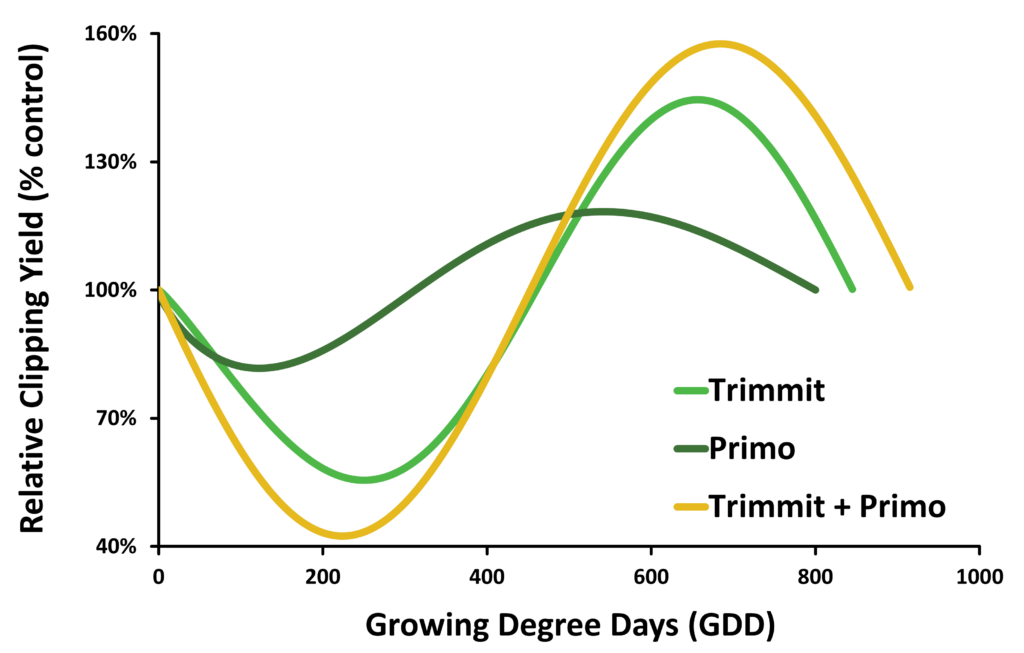
In all of these common cases of PGR over-regulation, programmatic applications of nitrogen fertilizer can help stimulate a more sustainable #ClipVol. A single higher nitrogen application rate rarely does the trick, especially when PGR damage is obvious. This result was first observed in some golf collar decline research I started in 2017 and 2018. During 2017, a rescue application of N was too slow to help. In 2018, we doubled the biweekly N application rate from 0.15 lbs to 0.30 for the entire season and the phytotoxicity minimized.
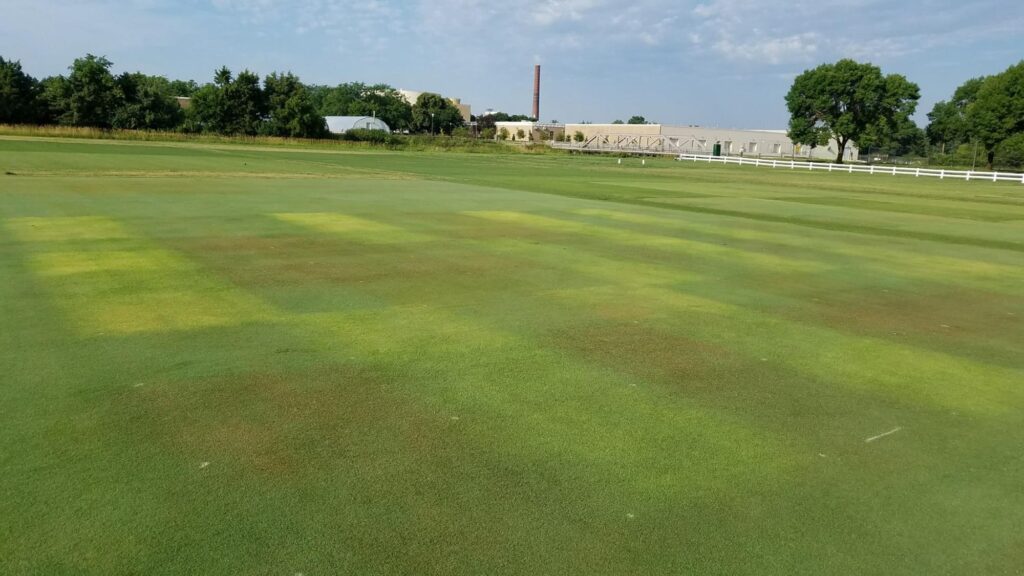
I can’t help but draw parallels to this research and common management of ultradwarf bermudagrass putting greens. Both generally receive light but very frequent applications of PGRs which can slowly accumulate in the plant. This can result in 70-95% clipping yield suppression. Extra nitrogen can help in this situations, but does it cause other issues? Mainly, how are green speed and surface organic matter levels affected by the additional fertilizer? Is additional cultivation like topdressing and aggressive verticutting required to thin the extremely dense canopy?
aggressive pgr applications influence bentgrass putting green performance
During 2020 and 2021, I conducted a study on a creeping bentgrass putting green at the University of Nebraska-Lincoln. The study goal was to measure surface characteristics when different PGR programs were paired with our standard nitrogen (0.15 lbs N/M) or double rate (0.30 lbs N/M) every two weeks. These treatments were applied to ‘007’ maintained at either 0.120″ or 0.080″ height of cut (HOC). The PGR treatments included a non-treated control, Primo MAXX (trinexapac-ethyl) at either 5.5 or 33 fl oz/A or Primo MAXX plus Trimmit 2SC (paclobutrazol) at 5.5 and 16 fl oz/A, respectively. Applications were made at the recommended 200 GDD interval from Primo MAXX alone or 280 GDD for the combination treatment. These results were presented at the Crop Science Society Annual meeting in 2021 and will be described in more detail in an upcoming GreenKeeper Blog article.
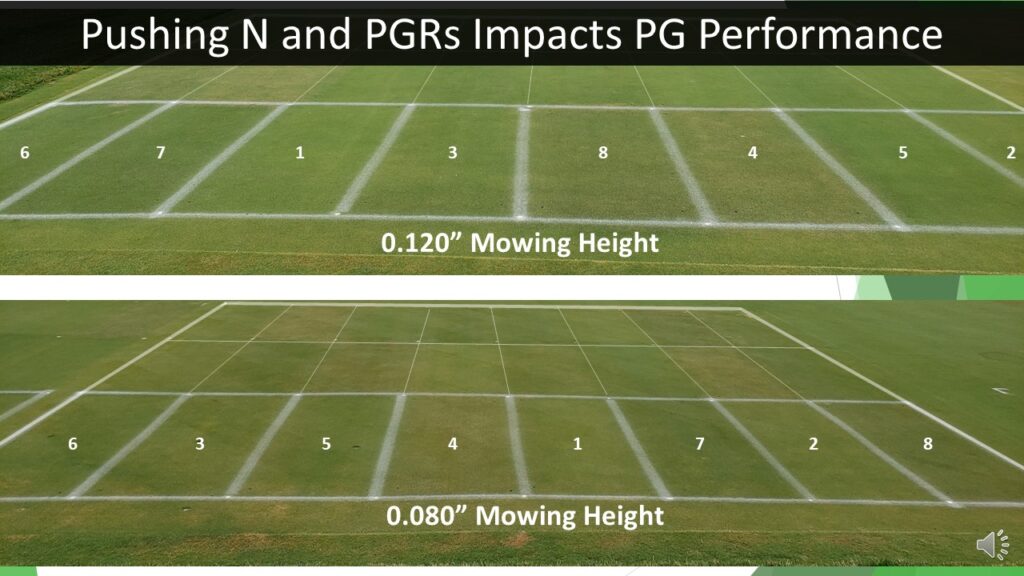
Relating to this article, the mixture of Primo MAXX and Trimmit 2SC suppressed clipping yield by an average of 75% at the 0.120 inch height of cut. This amount of suppression reduced turfgrass quality rating, but enhanced green speed by 8+ inches. Additional nitrogen fertilization applied to this PGR combo treatment improved turf quality rating but did not change clipping yield or green speed. The PGR combination treatment eliminated a growth surge from the added nitrogen. It was a surprising result.
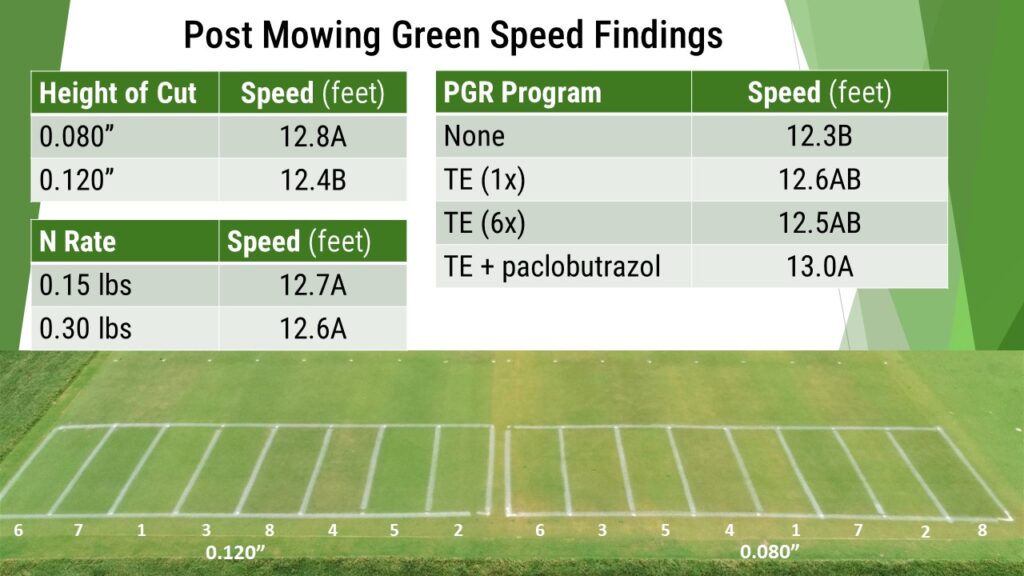
Is this high N/high PGR program the path to high performing bentgrass greens? I’d recommend we use some discretion. Past research frequently shows that additional nitrogen can improve green quality and health without hurting playability. But what are are the long-term effects of high N applications on turf that isn’t growing? There is certainly the potential to accumulate a lot of organic matter at the surface because nitrogen additions are greater than nitrogen removal during mowing. We have also found it difficult to incorporate topdressing sand into the very dense canopy. An alternative approach may be to focus on clipping yield (#ClipVol) to schedule N and PGR rates to avoid the potential for problems.
Back to the Tail Wagging Analogy
PGRs can definitely be a great tool to improve turfgrass health, quality and performance, but they can also cause problems when they produce excessive amounts of #ClipVol suppression. The idiom ‘Don’t let the tail wag the dog’ implies that a small part of something should not become so important that controls the whole thing. Don’t let your PGR program become so important that it necessitates broad management changes including additional fertilizer and cultivation. Instead, use PGRs to help hit growth rate goals with lower PGR rates during periods of low growth and higher PGR rates or even combinations when growth rate is very high.
The transition from a set aggressive PGR/high N program to a #ClipVol based approach needs to happen over time. For example, a ultradwarf bermudagrass superintendent that wants to move from a twice weekly Primo MAXX program to a GDD-based program focused on #ClipVol goals. That superintendent may have applied 0.2-0.4 lbs N/M every two weeks in the past to counteract the aggressive PGR program. Those past nitrogen additions will take time to leave that turf ecosystem through processes like clipping removal during mowing. As a result, higher PGR rates or even combinations may be required early on to hit growth rate goals as intervals are extended and N fertilizer rates are reduced. Over time, PGR rates can be reduced to achieve the desired growth rate.
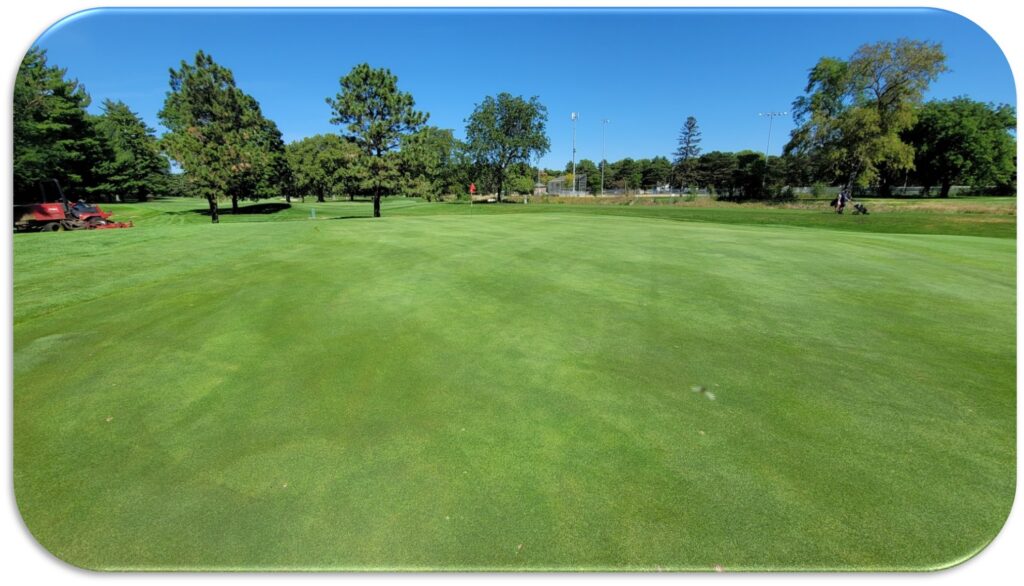
At Jim Ager GC – the course I manage in Lincoln, NE – the goal is to sustain 1.0 quarts of #ClipVol per 1000 square feet (1.0 L/100 m2). I apply a Class A PGR (i.e. Anuew or Primo MAXX) regularly throughout the year. I then add a Class B PGR (i.e. Cutless MEC or Trimmit 2SC) during the summer as growth rate increases, and I back off the Class B PGRs as growth rate slows in fall. My goal is to sustain 1.0 quart of #ClipVol per 1000 square feet (1.0 L/100 m2).
Early in the season I was applying higher nitrogen rates than I did towards the end of the season. It became clear that I was over-fertilizing by early July. My thoughts were, “Why should I be applying so much PGR to counteract this nitrogen?” and, “Where is all this nitrogen going if the growth rate is low?” It changed my perspective. I want to use N to keep the turf healthy with acceptable color and quality. It shouldn’t be a means to balance an aggressive PGR program.
I pivoted my management style in July. I wasn’t going to keep applying regular N unless turfgrass density, color, and overall quality rating indicated there was a need. If things looked lean, then I would make the app or increase the N fertilizer rate.. The standard Anuew rates serve as the baseline and I would be more flexible with Class B PGRs to make final adjustments based on #ClipVol. It seemed to make more sense, and the greens continued to perform well through the early fall.
The Future of Growth Management & Fertilization
So, how should we manage growth rate? Obviously it is a complex question. There are a lot of factors to consider, and it is difficult to guess where #ClipVol will be over the next day, week or month. This is challenging because we are applying fertilizers and PGRs based on those guesses. I’m optimistic for the future, however, because Dr. Soldat’s lab has shown how machine-learning algorithms can produce highly accurate predictive models for future growth rate. These models are not developed at a distant turfgrass research site. The use data collected at your course to build your own model (weather, performance data, past fertilizer and PGR applications, and #ClipVol data). These models will show where #ClipVol is headed weeks in advance to help schedule nitrogen and PGR applications. We are building this models into GreenKeeper App, so be sure to track your #ClipVol this summer to create your custom model for 2023.
Until the release of these new growth models in GreenKeeper App, I’d recommend being judicious with nitrogen applications to produce just enough #ClipVol to maintain acceptable quality and turf performance. A low rate of PGR will have a minimal impact on the clipping volume at this fertility level. When growth rate starts to spike, use higher PGR rates and PGR combinations to help stay within your #ClipVol goals. Don’t let your PGR program become so aggressive that it becomes the ‘Tail wagging the dog.’
